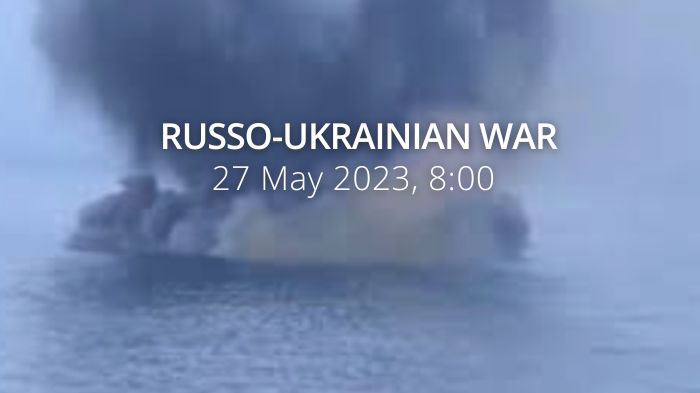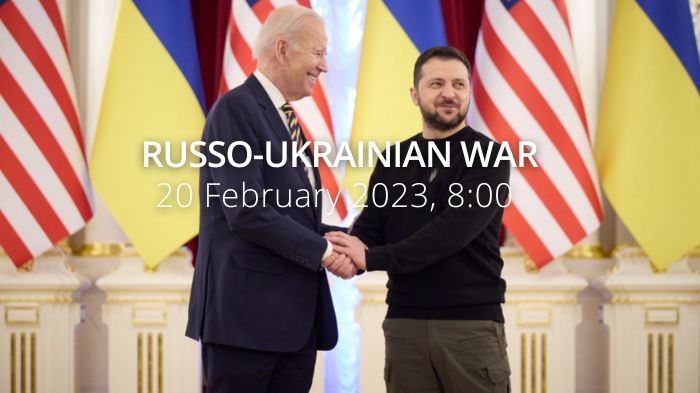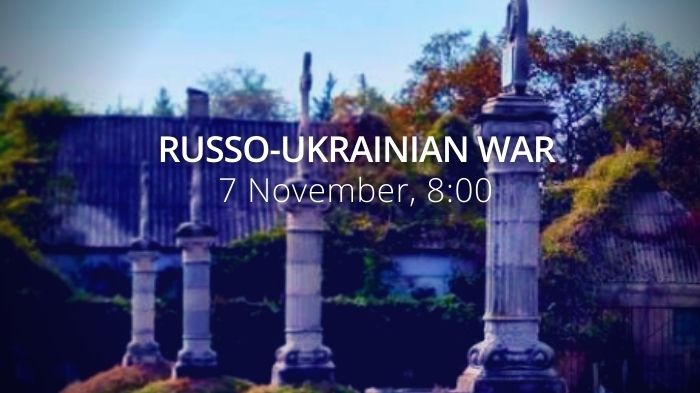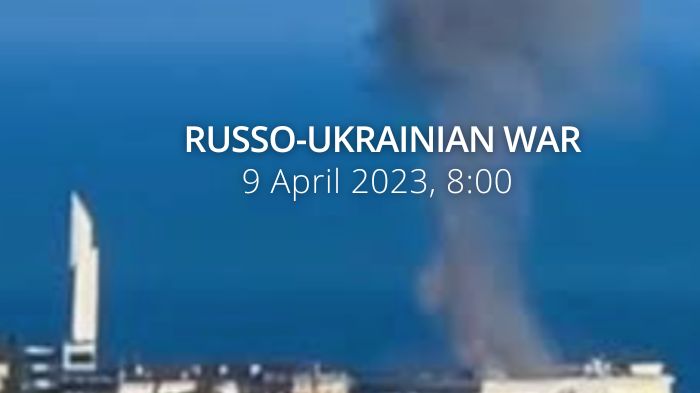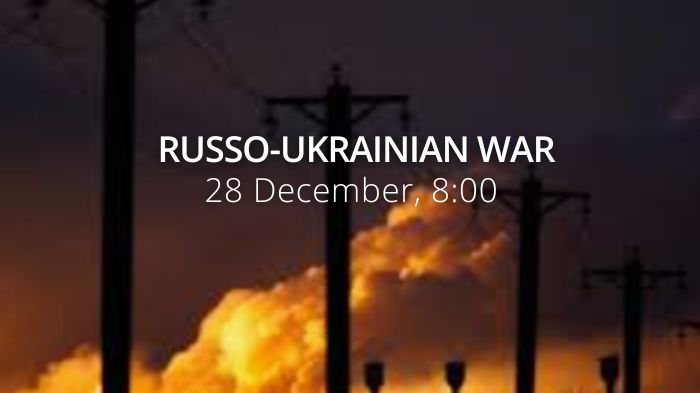Ukrainian military destroys 10 cruise missiles, 23 “Shahed” and two reconnaissance UAVs. Naval drones damage Russia’s intelligence ship. Wagner forces continue to hand over positions in Bakhmut to the Russian Ministry of Defense (MoD) and withdraw from the city.
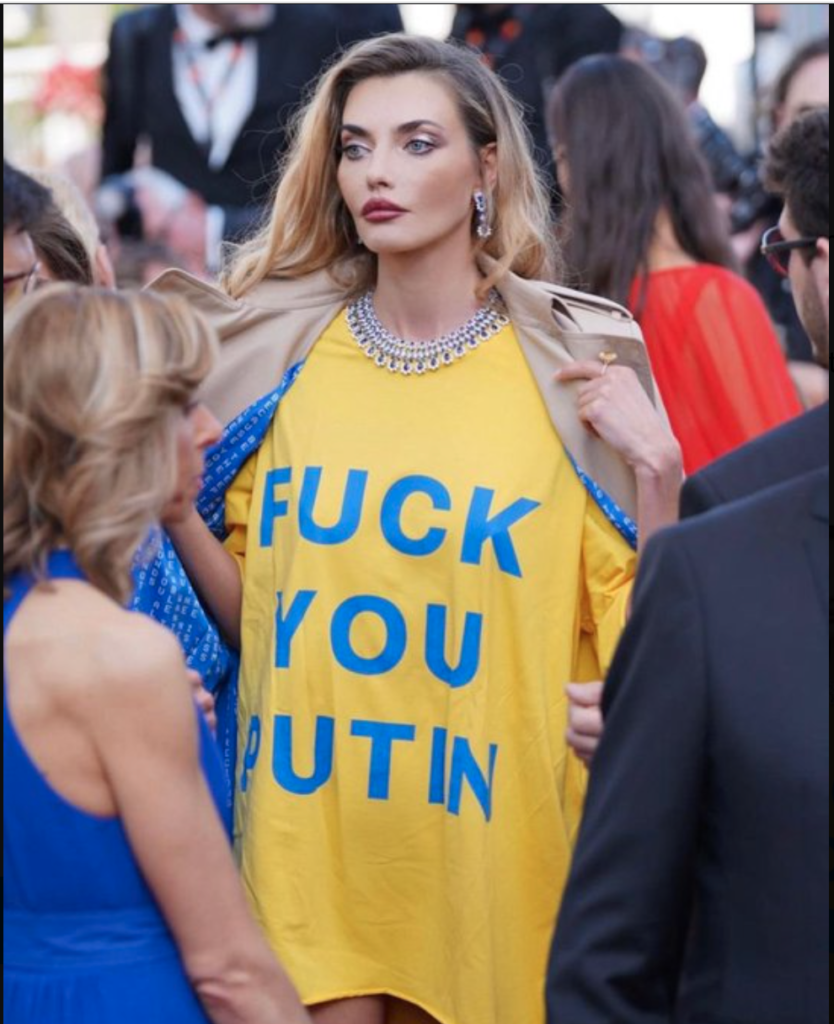
Ukrainian model Alina Baikova wears an exclusive outfit that the security guards don’t seem to appreciate.
Daily overview — Summary report, May 27
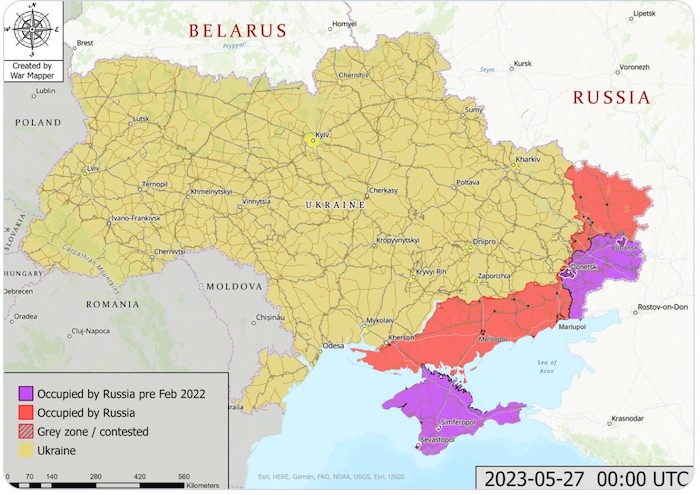
The General Staff’s operational update regarding the Russian invasion as of 18.00 pm, May 27, 2023 is in the dropdown menu below:
On May 27, the adversary launched 20 missile strikes. Russian forces fired 10 Kh-101 / Kh-555 air-launched cruise missiles at the settlements of Kyiv and Dnipro oblasts. Ukrainian defenders intercepted the missiles.
The adversary launched 2 missile attacks on Dnipro. First, the invaders used 7x S-300 / S-400 missiles. The second time, the occupiers fired Iskander missiles and hit a medical facility. Also, 2 Russian anti-aircraft guided missiles hit the city of Avdiivka.
In addition, Russian forces conducted 68 airstrikes. Some of them employed Iranian Shahed combat drones in the cities of Merefa and Izium (Kharkiv oblast) and guided aerial bombs in the city of Avdiivka and the village of New York. At the same time, the Russian aggressors launched 89 MLRS attacks at the positions of Ukrainian troops and various settlements. Unfortunately, the attacks have killed and wounded civilians and damaged a medical facility in Dnipro, educational institutions in Izium and New York, apartment buildings and private houses.
The likelihood of missile and air strikes across Ukraine remains high.
The adversary continues to focus its main efforts on Kupiansk, Lyman, Bakhmut, Avdiivka, and Marinka axes. On May 26, a total of 25 combat engagements took place in the above areas of the frontline.
- Volyn and Polissya axes: no significant changes.
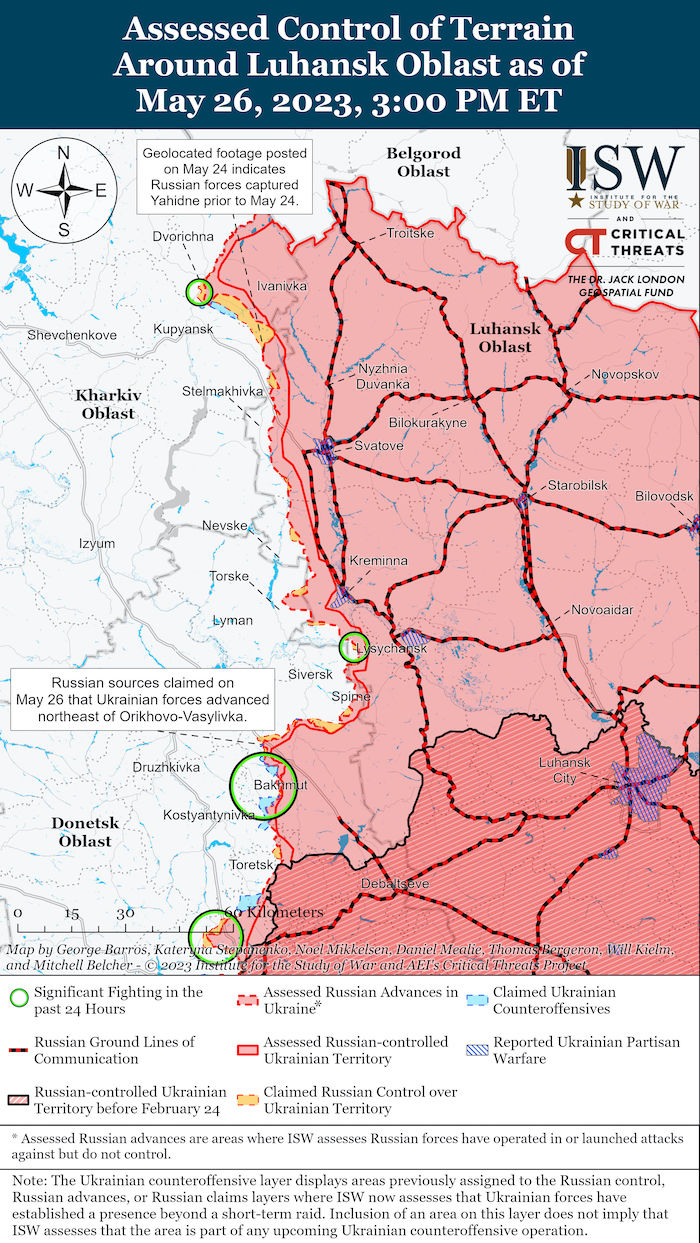
- Sivershchyna and Slobozhanshchyna axes: the adversary launched airstrikes at the vicinities of Strilecha and Zemlyanky (Kharkiv oblast), and fired mortars and artillery at the settlements of Sen’kivka, Sosnivka, Zaliznyi Mist (Chernihiv oblast), Svarkove, Boyaro-Lezhachi, Stari Vyrki, Pavlivka, Volfyne, Basivka, Zapsillya, Myropillya, Velyka Pysarivka (Sumy oblast), Odnorobivka, Kozacha Lopan’, Strilecha, Hlyboke, Neskuchne, Zelene, Ternova, Starytsya, Hatyshche, Vovchans’k, Karaichne, Mala Vovcha, Budarky, and Vil’khuvatka (Kharkiv oblast).
- Kupiansk axis: the adversary keeps trying to improve its tactical situation. The invaders launched airstrikes near Kyslivka, Kotlyarivka, Tabaivka, and Raihorodok (Kharkiv oblast). Russian forces conducted unsuccessful offensive operations in the vicinity of Masyutivka. Kolodyazne, Dvorichna, Masyutivka, Kyslivka, Kam’yanka (Kharkiv oblast), and Stel’makhivka (Luhansk oblast) came under artillery and mortar fire.
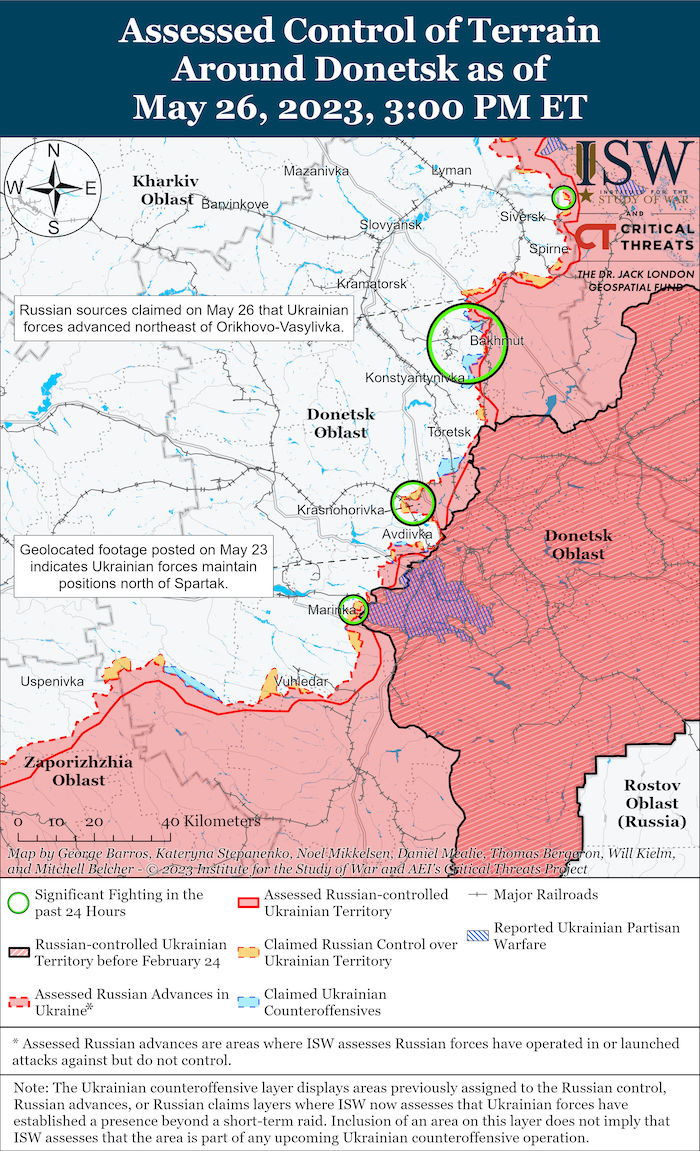
- Lyman axis: On May 26, the adversary conducted unsuccessful offensives and launched an airstrike in the vicinity of Bilohorivka. Nevske, Dibrova, Bilohorivka (Luhansk oblast), Verkhn’okam’yans’ke, and Spirne (Donetsk oblast) were shelled with artillery.
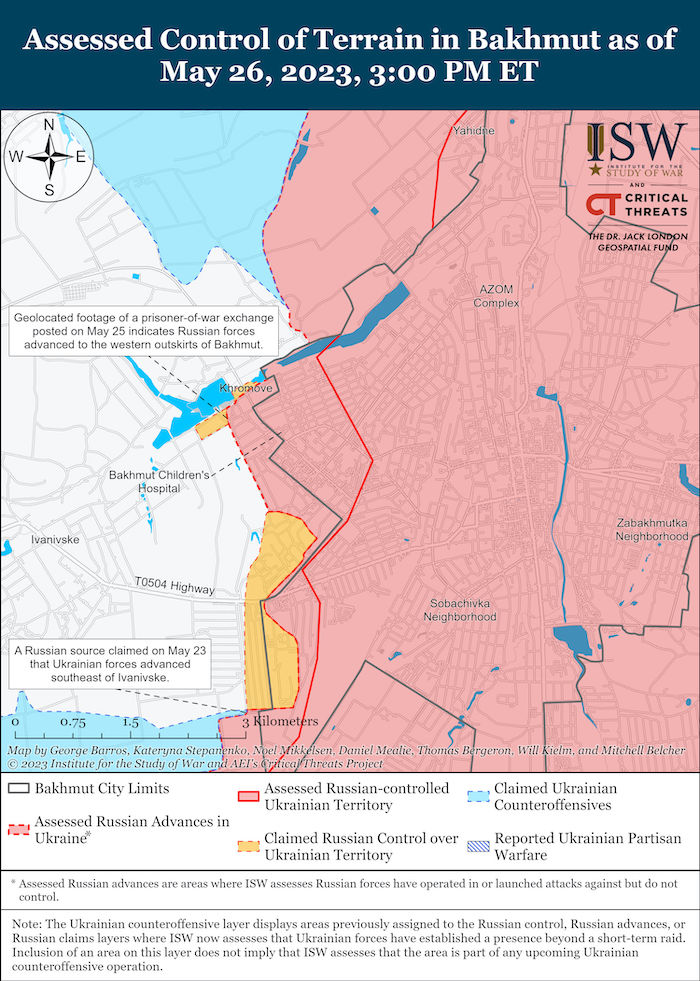
- Bakhmut axis: the adversary conducted unsuccessful offensives towards Predtechyne. Russian aircraft launched an airstrike in the vicinities of Hryhorivka and Bila Hora. Vasyukivka, Pryvillya, Orikhovo-Vasylivka, Hryhorivka, Bakhmut, Kalynivka, Chasiv Yar, Ivanivske, Stupochky, Predtechyne, Kostyantynivka, Bila Hora, and Pivnichne (Donetsk oblast) came under enemy fire.
- Avdiivka axis: the adversary conducted offensive operations towards Pervomais’ke, to no success. The invaders launched airstrikes on Avdiivka and Pervomaiske, and fired artillery at the settlements of Avdiivka, Pervomais’ke, Karlivka, and Nevel’s’ke (Donetsk oblast).
- Marinka axis: Ukrainian defenders repelled numerous enemy attacks in the vicinity of the city of Marinka. At the same time, the settlements of Heorhiivka and Pobjeda (Donetsk oblast) were shelled by Russian forces.
- Shakhtarske axis: Russian forces launched airstrikes in the vicinities of Vuhledar, Prechystivka, and Velyka Novosilka, shelled the settlements of Paraskoviivka, Vuhledar, and Prechystivka.
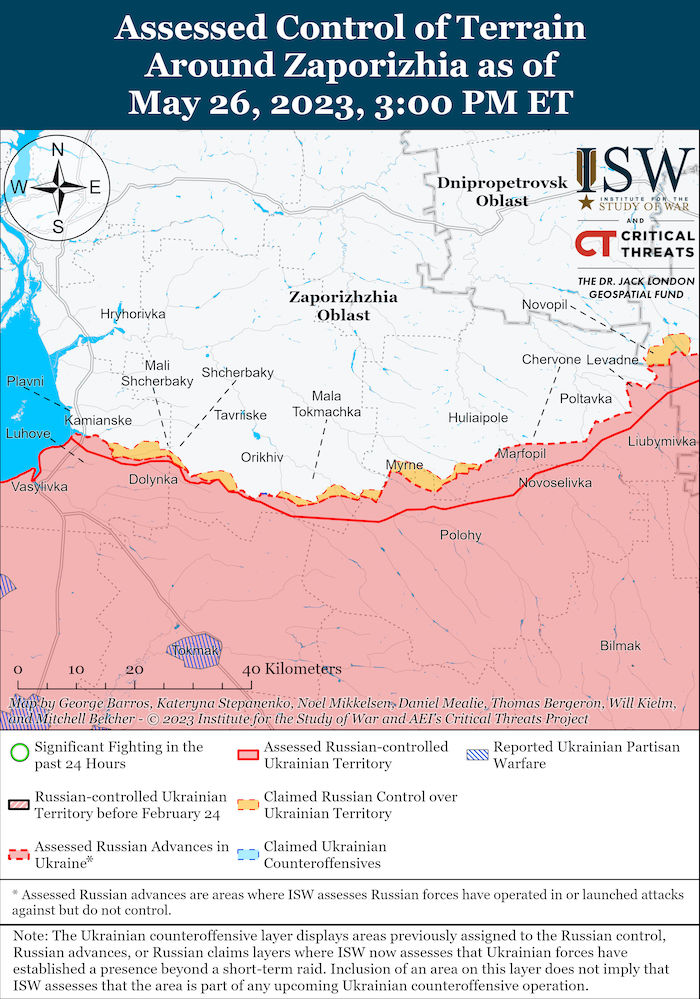
- Zaporizhzhia and Kherson axes: the adversary stays on the defensive. The invaders launched airstrikes near Stepove (Zaporizhzhia oblast) and Zmiivka (Kherson oblast). Russian forces shelled the settlements of Vremivka, Novosilka’ (Donetsk oblast), Ol’hivs’ke, Hulyaipole, Zaliznychne, Bilohir’ya, Mala Tokmachka, Mali Shcherbaky, Kam’yans’ke (Zaporizhzhia oblast), Zolota Balka, Vesele, Kozats’ke, L’vove, Antonivka, Kizomys, Stanislav (Kherson oblast), and the city of Kherson.
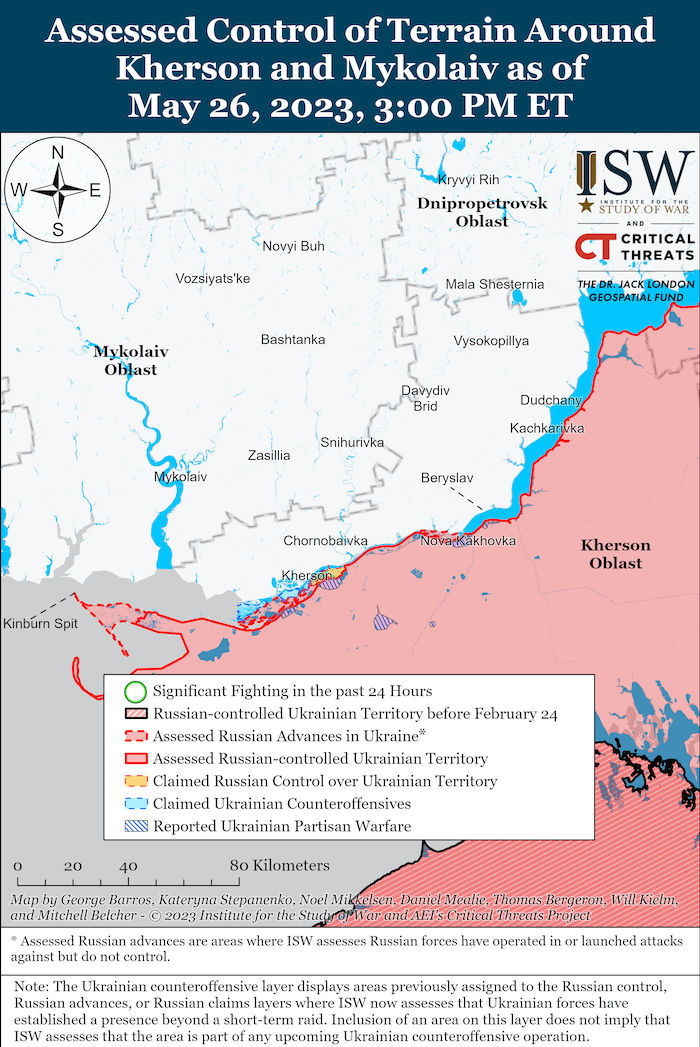
There are reports of increasing cases of disobedience to orders and desertion in the Russian occupation forces. Thus, on May 25, about 20 former convicts who had recently undergone accelerated training and arrived to reinforce a unit located near the settlement of Svatove, hijacked a KamAZ truck to leave for an unspecified location. Their whereabouts are currently unknown, and the search is ongoing.
[Several dozen Russian troops arrived in the temporarily captured Novopetrykivka of the Donetsk Oblast to carry out so-called “counter-sabotage measures“. Invaders search private houses, seize mobile devices, and illegally take possession of local residents’ vehicles. However, they are simply robbing citizens.]
On May 26, Ukrainian Air Force launched 11 air strikes on the concentrations of troops and military equipment of the adversary. Also, 5 Orlan-10 reconnaissance UAVs and 2 Zala UAVs of Russian forces were intercepted.
The Ukrainian missile and artillery troops hit 3 command posts, 3 concentrations of weapons and military equipment, 2 ammunition depots, 2 artillery units at their firing positions, 1 air defence asset, and 2 other important targets of the adversary.
Military Updates

10 cruise missiles, 23 “Shahed” and two reconnaissance UAVs destroyed during the night 25/26 May, the Ukrainian General Staff reports. “Another night attack by the Russian occupiers began at the end of the previous day on May 25 at 10 p.m. and lasted until 5 a.m. on May 26. This time, the enemy shifted the direction of attack to the East, attacking critical infrastructure facilities and the facilities of the Defence Forces of Ukraine.
In total, the launches of 17 missiles of various types and 31 strike drones were recorded: 10 Kh-101/kh-555 cruise missiles from Tu-95ms aircraft from the Caspian Sea region; 7 S-300/S-400 anti-aircraft guided missiles from Tokmak district (so-called Zaporizhzhia region); 31 strike UAVs of Iranian production “Shahed-136/131” from the southern and northern directions.
10 Kh-101/kh-555 air-based cruise missiles; 23 attack drones “Shahed-136/131”; and 2 Orlan-10, Merlin-VR UAVs of operational and tactical level were destroyed.
Strike UAVs and several S-300/S-400 anti-aircraft missiles hit the Kharkiv and Dnipropetrovsk regions. Local military administrations will report on the consequences of the strike.”
Russians looking for new routes for “Shahed” – Humeniuk, Ukrinform reports, citing Natalia Gumenyuk, head of the Joint Press Centre of the Southern Operational Command. “The enemy was trying to draw the attention of the air defence and attack from different directions. This time, in the southern direction, the enemy, already trained by air defence, was looking for new routes […] and launched them through the temporarily occupied territory of the Kherson region, then through the de-occupied Kherson region, and over the Mykolaiv region, two “Shaheds” were destroyed by air defence forces. […]
According to her, the Russian army is continuing air attacks in the frontline area. The right side of the river is suffering from shelling because the invaders are using tactical aircraft at a distance that is not yet accessible to air defence systems. They are trying to attack with different weapons forces so that those air defence systems that work effectively cannot operate in this mode. And to detect them.
They are trying to use wave-like attacks precisely to see where the defence was coming from and where to strike later, Humeniuk said. According to the head of the Joint Press Centre of the Southern Military Command, Russia will continue to use ballistic missiles, among other things. This tactic helps to verify where and in what capacity and in which regions air defences are operating.
That’s why we made sure that in no case should we announce the operation of air defences or communicate them in a visual context. This is our defence, and we need to realise that it is more important than a bright video or photo, Humeniuk added.”
Ukraine shoots down 10 missiles in Russian attacks, oil depot hit, Reuters reports. “Ukraine shot down 10 missiles and over 20 drones launched by Russia in overnight attacks on the capital Kyiv, the city of Dnipro and eastern regions, Ukrainian officials said on Friday. President Volodymyr Zelenskyy’s office said in a statement that a fire had broken out on the outskirts of the northeastern city of Kharkiv after an oil depot was hit twice, and that equipment for pumping oil products had been damaged.
Russia has intensified missile and drone attacks on Ukraine this month, mainly attacking logistics and infrastructure facilities before an expected Ukrainian counteroffensive.”
Russia sending reinforcements to Berdiansk, Mariupol, Ukrinform reports, citing Petro Andriushchenko, an adviser to the Mariupol mayor. “Reinforcements are arriving in Berdiansk and the Mariupol district. Motorized infantry equipment, manpower and Pantsir air defence systems, Andriushchenko wrote.
According to him, newly mobilized soldiers were moved to the coast along the Urzuf-Yalta line. In this connection, the training ground near the village of Babakh-Tarama in the Mariupol district resumed its work.
In addition, military personnel and hardware, including tanks, are concentrated in the north of the Mariupol district, closer to Volnovakha/Vuhledar. The reverse movement to Muscovy has not been recorded, Andriushchenko added.”
Border guards and army repel 10-hour Russian assault near Avdiivka in spite of a chemical attack, Ukrainska Pravda reports, citing the State Border Guard Service of Ukraine. “Recently, in the area of Avdiivka, border guards, together with soldiers of one of the mechanised brigades of the Ukrainian Armed Forces, repelled a prolonged attack by the superior forces of the invaders. The assault on the positions was preceded by massive artillery preparation and the use of chemical grenades. Ammunition with irritant aerosols was dropped by enemy forces from drones. […]
In total, the battle lasted about ten hours. The occupiers failed to succeed due to heavy losses and retreated. Approximately more than 30 occupiers were killed, and more than 50 were wounded.”
Naval drones damage Russia’s intelligence ship, Ukrainska Pravda reported on Thursday. “The Russian Yury Ivanov intelligence ship has been damaged as a result of an attack by Ukrainian naval drones in the waters of the Black Sea. On 25 May, a video appeared on Telegram channels showing how a Ukrainian unmanned gunner hit the Russian Yury Ivanov intelligence ship of the Black Sea Fleet of the Russian Federation.
The recording was distributed, in particular, by the unofficial channel of the Ukrainian military, Operational ZSU (Armed Forces of Ukraine, AFU). The UP source confirmed the authenticity of the video and noted that the Russian ship was damaged as a result of the attack. It did not sink, but there was a hit and there is significant damage to the hull and equipment. Now the Russians are hastily repairing it.”
Drones attack buildings in Belgorod region, Krasnodar – social media, Ukrinform reports, citing the Telegram channel Baza. “A drone attacked a Gazprom building in Russia’s Belgorod region bordering Ukraine late on Thursday, May 25. The incident occurred in the village of Oktyabrskiy at 23:00 on May 25. The UAV dropped a bomb on the Gazprom building. The windows were broken, and the facade and roof of the building were damaged.
At 04:17 on May 26, drones attacked the building of an unnamed institution in Russia’s Krasnodar. The roof of the building was damaged. According to reports, there were two drones, and one of them was shot down.
After Russia started its full-scale war against Ukraine, various targets across Russia come under drone attacks.
Ukrainian military advances another 350-400 meters near Bakhmut – Ukraine army spox
According to British Defence Intelligence, (last 48 hours):
- Wagner Group forces have likely started to withdraw from some of their positions around the Donetsk city of Bakhmut.
- On 25 May 2023, Wagner owner Yevgeny Prigozhin said the withdrawal of his forces from Bakhmut had begun and that transfer of positions to the Russian Ministry of Defence (MOD) would continue to 01 June 2023. The Ukrainian Deputy Defence Minister also corroborated the rotation out of Wagner forces in the outskirts of the town.
- As of 24 May 2023, so-called Donetsk People’s Republic (DNR) forces have likely entered the city to start clearance operations. In recent weeks, elements of the 31st Brigade of Russia’s Airborne Forces (VDV) have likely moved from the Svatove-Kreminna area to reinforce Bakhmut’s flanks.
- Ukrainian forces had taken 20 square kilometres on Bakhmut’s flanks as of 16 May 2023. The rotation out of Wagner forces is likely to continue in controlled phases to prevent collapse in pockets around Bakhmut. Despite Prigozhin’s ongoing feud with the Russian MOD, Wagner forces will likely be used for further offensive operations in the Donbas following reconstituting its forces.
- Over at least the last 20 years, Russia has experienced a proliferation of paramilitary groups out of its regular armed forces. However, this ‘paramilitarisation’ has dramatically accelerated since Russia’s invasion of Ukraine and is particularly important in the Crimean Peninsula.
- The leader of Russian-occupied Crimea, Sergei Aksyonov, has been instrumental in setting up several local units, which often claim affiliation with the Cossack tradition. Most have been given some semi-official status as reserve units of the regular army.
- Aksyonov is likely keen to burnish his patriotic credentials by recruiting fighters, but he is likely also concerned about the regular army’s ability to defend the peninsula. The main element of the Russian garrison, 22nd Army Corps, is currently mostly deployed outside the peninsula and has taken heavy casualties.
Losses of the Russian army
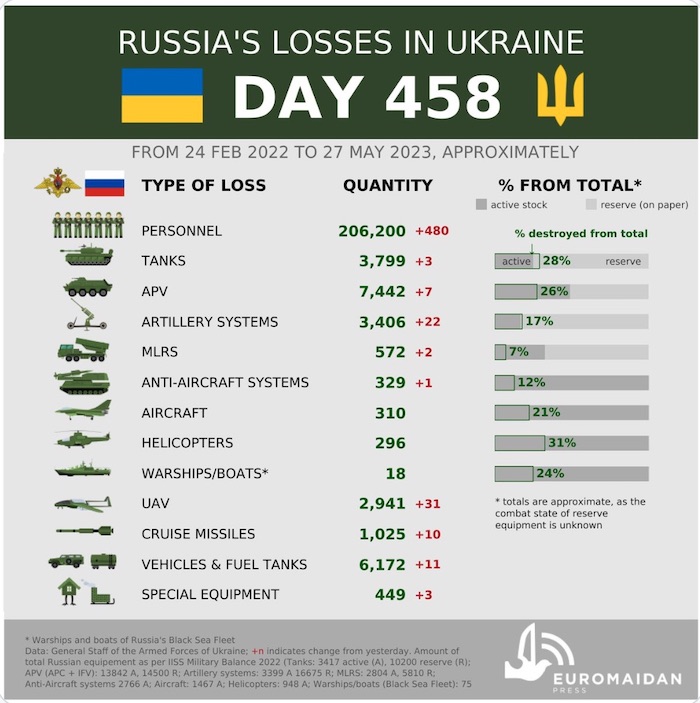
As of Saturday 27 May, the approximate losses of weapons and military equipment of the Russian Armed Forces from the beginning of the invasion to the present day:
- Personnel – about 206200 (+480)
- Tanks – 3799 (+3)
- Armoured combat vehicles – 7442 (+7)
- Artillery systems – 3406 (+22)
- Multiple rocket launchers –MLRS – 572 (+2)
- Air defence means – 329 (+1)
- Aircraft – 310 (+0)
- Helicopters – 296 (+0)
- Automotive technology and fuel tanks – 6172 (+11)
- Vessels/boats – 18 (+0)
- UAV operational and tactical level – 2941 (+31)
- Special equipment – 449 (+3)
- Mobile SRBM system – 4 (+0)
- Cruise missiles – 1025 (+10)
In Russia, children will be sent to patriotic camps and taught to shoot and fly UAVs, Ukrainska Pravda reports, citing Krym.Realii outlet with reference to the press service of the Plenipotentiary Representative of the President in the Far Eastern Federal District of the Russian Federation. “More than 9,000 Russian teenagers will attend military-patriotic camps by the end of the summer, where they will receive fire training and study tactical medicine and UAV piloting.
Teenagers aged 14 to 17 will receive fire, tactical, and engineering training, learn the basics of tactical medicine, as well as the organisation of communication and piloting of UAVs. Pupils will meet with veterans of the Great Patriotic War and “special military operation” (the war in Ukraine – ed.), famous sportsmen, and they will also study the history of Russia based on the examples of feats of Soviet and Russian soldiers and officers, military and civilian volunteers.
It is reported that the first summer shift will be held under the motto “Time of Heroes”. It will last for 21 days. The organiser is the “Voin” military and sports training centre, created on the initiative of Sergey Kirienko, the deputy head of the presidential administration.”
Russian arms maker Kalashnikov boosts output of kamikaze drones, Reuters reports. “Russian arms maker Kalashnikov, maker of the world’s most widely used assault rifle, said on Friday it was launching a new division for the production of kamikaze drones – one of the key weapons used in the Ukraine war. After Ukrainian forces used Western, Israeli and Turkish uncrewed aerial vehicles (UAVs) with deadly efficiency in the opening months of the war, Russia began using Iranian-made Shahed drones while seeking to boost its own production. […]
The main task of the division is the production of complexes with guided loitering munitions. The complexes are designed for high-precision destruction of remote single and group enemy ground targets. […] In 2024, we will be able to increase by several times the number of UAVs produced in our traditional niche – loitering munitions and reconnaissance drones, Kalashnikov President Alan Lushnikov said. He did not give figures.”
Humanitarian
27 May declared day of mourning in Dnipro, Ukrainska Pravda reports, citing Mayor of Dnipro Borys Filatov. “In Dnipro, 27 May has been declared a day of mourning for those killed in the Russian missile attack on a medical institution on Friday. Filatov reported that the missile attack destroyed the wing of a medical institution where psychiatric care was provided. He emphasised that there were no military facilities there. As of 16:00, 26 people are known to be injured, including two children. Two people have been killed.
On 26 May, Russian troops launched a missile attack on a health centre and a veterinary clinic in Dnipro, in spite of the fact the Geneva Convention bans such attacks on civilian infrastructure. As a result, at least two people were killed and 23 people were injured, including 2 children born in 2020 and 2017. As of 13:50, the fires in both buildings had been extinguished.”
Register of missing people includes 23,000 names, 1500 bodies of soldiers returned to Ukraine, Ukrainska Pravda reports, citing Oleh Kotenko, Commissioner for Issues of Missing Persons under Special Circumstances, cited by Interfax-Ukraine and Ukrinform. “Since the beginning of May, the Unified Register of Missing Persons under Special Circumstances has been operational… All relatives who are looking for missing people who applied to the National Police with a statement about a missing person and those who applied to the Office of the Commissioner for Missing Persons about missing people have been added to this register. This is more than 23,000 people. […]
Kotenko added that during the year of operation of the Office, the whereabouts of about 8,000 missing persons were determined. The Office of the Commissioner for Missing Persons under Special Circumstances checked about 150 liberated settlements for burial sites, worked over 500 locations in the de-occupied territories and recovered the bodies of more than 1,500 fallen soldiers.”
Black Sea grain deal slow to get moving after extension, Reuters reports. “A deal allowing the safe wartime export of grain and fertilizer from Ukrainian Black Sea ports has not yet resumed full operations, the United Nations said on Friday, having come to a halt before Russia’s decision last week to extend it. The pact called the Black Sea Grain Initiative, brokered by the United Nations and Türkiye last July with Russia and Ukraine to try to ease a global food crisis aggravated by Moscow’s invasion of Ukraine, covers three ports, but no ships have been authorized to travel to Pivdennyi (Yuzhny) port since April 29, the UN said. […]
Ukraine accused Russia on Tuesday of effectively cutting Pivdennyi port out of the Black Sea deal as Russia complained that it had been unable to export ammonia via a pipeline to Pivdennyi under the agreement. The UN said on Friday that the Black Sea deal also provides for the exports of fertilizer, including ammonia, but there have been no such exports so far.
Under the Black Sea grain export agreement a Joint Coordination Centre (JCC) in Istanbul – made up of officials from the Ukraine, Russia, Türkiye and the UN – authorizes ships and conducts inbound and outbound inspections of the vessels. According to information shared by the Ukrainian delegation with the parties at the JCC, there are 54 vessels waiting to move to Ukrainian ports. Out of these, 11 applications have been shared with the JCC for registration, the UN said. […] It also said that the average number of daily inbound and outbound inspections had dropped to 3.2 during May – the lowest level since operations began in August.”
Environmental
Russians prepare large-scale provocation at Zaporizhzhia nuclear plant, Ukrainska Pravda reports, citing the press service of Ukraine’s Defence Intelligence “Ukraine’s Defence Intelligence has reported that in the coming hours, Russian invaders are preparing a large-scale provocation to simulate an accident at the Zaporizhzhia Nuclear Power Plant (ZNPP).
According to Defence Intelligence, it will be carried out directly on the territory of the ZNPP. After that, the invaders will announce an emergency leak of radioactive substances. Ukraine will, as ever, be blamed for the incident. In order to conceal what they are doing as much as possible; the Russians have disrupted the IAEA permanent monitoring mission personnel rotation scheduled for 26 May, Defence Intelligence notes.
The purpose of this action is to provoke the international community into conducting a detailed investigation during which all hostilities will be suspended. In this way, the invaders hope to gain a much-desired pause, which they will use to regroup their ranks and stop the Ukrainian counteroffensive, the intelligence officers summed up.”
Ukraine world’s most mine-polluted country – UN coordinator, Ukrinform reports. “The UN is participating in humanitarian demining in Ukraine, which will allow farmers to resume agricultural operations in the frontline regions. This was reported by the UN Resident Coordinator in Ukraine, Denise Brown, during a speech at the 15th annual Kyiv Security Forum, founded by the Arseniy Yatsenyuk Foundation Open Ukraine.
It is our responsibility with the government, with the SESU, to work on agricultural demining. Because you unfortunately the most contaminated country in the world. And unless the agricultural land is declared mine-free, those farmers won’t get back to work, she said.
The Resident Coordinator also emphasized that the organization provided unprecedented assistance to Ukraine. She also emphasized that in order to ensure the appropriate level of humanitarian support for Ukrainians, the staff of the organization was increased multiple times: while the team consisted of nearly 200 people previously, it currently numbers 3,000 members, 60% of which are Ukrainians.”
Legal
French Foreign Ministry: Russian missile attack on hospital in Dnipro is criminal, Ukrainska Pravda reports, citing European Pravda. “On 26 May, Russian troops launched a missile strike prohibited by the Geneva Convention on a health centre and a veterinary clinic in the city of Dnipro. In a statement released Friday, the French Foreign Ministry condemned in the “strongest possible terms” the strikes targeting the city of Kyiv and Kharkiv and Dnipropetrovsk oblasts, stressing that it was the thirteenth attack on Ukraine’s capital since the beginning of May.
These strikes once again deliberately targeted civilian objectives, including a hospital in Dnipro, in flagrant violation of international humanitarian law, they said. As Minister for Europe and Foreign Affairs Catherine Colonna has stressed repeatedly, these unacceptable actions are war crimes and cannot go unpunished, the French Foreign Ministry added.
The French side stressed that it will support the Ukrainian courts and the International Criminal Court in bringing those involved in these crimes to justice, as well as provide Ukraine with humanitarian and military support.”
Russia has carried out more than 900 attacks on Ukrainian medical facilities – WHO, Ukrinform reports, citing CNN. “There have been more than 900 attacks on health care in Ukraine since the Russian invasion began, according to the latest figures from the World Health Organization. Of the 967 total attacks, 868 of them impacted medical facilities, WHO data shows. In total, strikes on health care in Ukraine have resulted in at least 97 deaths and 126 injuries since February 25, 2022.
Russia’s attack on a medical facility in Dnipro city on Friday is not yet included in the WHO data or death toll, given that the organization’s process for verifying attacks takes some time. WHO condemns all acts of violence against healthcare. These attacks not only kill and maim but also deprive people of urgently needed care, endanger healthcare providers, and undermine health systems, WHO spokesperson Dr. Margaret Harris said in a statement to CNN.
She added that attacks on health care workers, patients, transport, supplies, and health facilities are a flagrant violation of international humanitarian law and human rights law. We call for an immediate cessation of all activities that endanger the lives of health care workers and patients or impede delivery of essential health services, she added.”
Support
NATO considers enhanced partnership for Ukraine without details on its accession – Media, European Media reports. “NATO members are set to offer Ukraine an upgraded relationship format, although any concrete roadmap for accession still remains a more distant prospect. According to Euractiv, several diplomats from NATO member countries have revealed that NATO countries are looking to upgrade Ukraine’s status in its relationship by setting up a “Ukraine-NATO Council.”
NATO foreign ministers are set to meet in Oslo next week where they are expected to discuss the shape and the timeline of the new council and future membership, as well as the need for more military aid to Ukraine as it prepares for its summer offensive against Russia. Under the plan, Ukraine would be a “full-fledged” member around the Ukraine-NATO Council table instead of being only invited for discussions as is the case now. Kyiv could then call for meetings when they wish, and it would be easier to give a direct update on the situation on the battlefield, two people with knowledge of the discussions said.
Those could include more intelligence sharing and consultations, joint exercises, investment in the defence industry, and work on the interoperability between Ukraine’s and the NATO member states’ armed forces, giving Kyiv the option to align with NATO’s communiqués and standard. In these discussions, some NATO member states have pointed out that Russia – Ukraine’s aggressor – has a joint NATO-Russia Council, although meetings are no longer taking place, while their partner Ukraine does not.
Many NATO diplomats acknowledge a fast-track membership is not an option, some wish to officially put Kyiv on the path to membership. Countries in Eastern Europe believe NATO needs to make it clear that Ukraine will be a member of the alliance after the war, two NATO diplomats said, calling for a roadmap or concrete plan to accession.
According to Euractiv, key member states such as the United States and Germany were very cautious while Hungary remained firmly opposed because of bilateral problems with Ukraine, and Europe’s big powers such as France and the UK found themselves in the middle ground. In private conversations, Ukrainian officials acknowledge that they should not expect immediate NATO membership but they request a strong signal from allies. NATO Secretary-General Jens Stoltenberg stated at a recent public event that while no one can say for certain what decision to expect for Ukraine at the summit in Vilnius, everyone agrees that Ukraine will become a NATO member.
Meanwhile, The Wall Street Journal unofficially learned that NATO key members have preliminarily supported the idea of providing Ukraine with security guarantees prior to its membership based on the Kyiv Security Compact.”
Kyiv Security Forum calls on NATO to grant Ukraine membership, Ukrinform reports. “At its upcoming summit in Vilnius, NATO must make a political decision to offer Ukraine membership in the military alliance and begin accession negotiations. That’s according to a policy paper of the Kyiv Security Forum entitled “Fighting for NATO,” which was presented during the 15th Annual Kyiv Security Forum.
The document states that the main obstacle on Ukraine’s path to NATO for many years was a lack of political will from both sides. Instead of accepting Ukraine – a historic step which could have ensured common security and halted Russia’s growing geopolitical and military ambitions – many political leaders preferred to postpone and leave aside for an indefinite future. This turned out to be a tragic mistake, the document reads. At the same time, it adds that the war has changed it all: Ukraine’s national resistance against Russia’s aggression made a real breakthrough in the security vision of the Alliance. Ukraine proved to be a stronghold of common security.
The authors of the document said that nothing may substitute Ukraine’s NATO membership now – neither special formats nor temporary security arrangements. The Kyiv Security Forum emphasized the need to move rapidly from words to action and expressed hope that the NATO summit in Vilnius would be a turning point in the issue of Ukraine’s membership in the Alliance.
The document calls on the Allies to make a political decision to offer membership to Ukraine and start accession negotiations. In addition, it calls for the beginning of talks within the Alliance on offering Ukraine Article 5-like collective defence guarantees for the period before its accession to NATO. Without uncompromised clarity on Ukraine’s accession, once again we would risk that the war in Europe never ends and Ukraine’s NATO membership becomes a bargaining point in political talks instead of becoming a founding element of a new European security architecture, the document said.”
Austin announced Ramstein’s agreement on training of Ukrainian pilots on F-16s, Ukrainska Pravda reports, citing Lloyd Austin, United States Secretary of Defence. “I want to especially thank Denmark and the Netherlands, who have decided to lead the European coalition to provide F-16 training for Ukrainian forces. In the coming weeks, my Danish and Dutch counterparts will work with the US and other allies to develop a framework for the exercise.”
He added that Norway, Belgium, Portugal, and Poland have also offered to contribute to the training. We expect that more countries will soon join this initiative, the US Defence Secretary emphasised. […] Ukrainian pilots will train on F-16 fighters at military bases in Europe, the Pentagon said earlier.”
Netherlands may send F-16s to Ukraine after pilot training – Bloomberg, Ukrainska Pravda reports, citing Bloomberg, citing two individuals familiar with the matter. “The Dutch government has been in talks with US officials in recent weeks to get President Joe Biden’s administration to give the “green light” for the aircraft supply to Ukraine, the agency’s sources said. The Netherlands has been exploring and discussing the plans to train Ukrainian pilots with its allies. […]
The Netherlands currently has 42 F-16 fighter jets in service, including 24 currently in use by the country’s defence forces, which cannot be transferred to Ukraine until mid-2024. Another 12 of the 18 aircraft were to be sold to Draken International, but the government postponed the deal in December without explanation. Ukraine is likely to receive some of the aircraft planned to be sold or some of the 24 aircraft from the Dutch forces next year, depending on the training schedule.”
Milley explains why the West delayed decision on F-16s for Ukraine, Ukrainska Pravda reports. “General Mark Milley, the chairman of the Joint Chiefs of Staff of the United States, said that the F-16 fighters would not currently be effective enough to provide air defence, as Russia maintains a significant superiority in the air. According to the top general of the US, one of the key issues in providing Ukraine with the F-16s is ensuring control over the airspace.
The fastest and cheapest way to protect airspace is to do it from the ground and provide effective ground-based air defence systems. This is the most effective way to prevent the Russians from gaining air superiority, and that’s exactly what we did, he said.
As for the F-16: the plane itself costs a billion dollars, its maintenance costs another billion dollars. That is, one plane costs two billion dollars. The Russians have thousands of fourth- and fifth-generation fighter jets. Therefore, in order to oppose them in the air, a significant number of fourth- and fifth-generation fighters are needed, added Milley.
He, however, pointed out that in the future the F-16s will play their part in Ukraine’s Air Force, but it will take a considerable amount of time to build up an air force of the necessary volume and firepower.”
Canada to donate 4,800 assault rifles, one million rounds of ammunition to Ukraine, Ukrinform reports, citing the Canadian Defense Ministry. “Delivery of the donation packages of small arms and ammunition announced in April is on track. Machine guns, assault rifles, cleaning kits, and magazines have already been delivered to Ukraine, and 1 million rounds of 5.56mm ammunition and 4,800 assault rifles are scheduled to be delivered in the coming weeks,” the report said.
The ministry said that all 21,000 small arms and 2.4 million rounds of ammunition are expected to be in Ukraine by the summer.”
US senator calls on Biden administration to transfer ATACMS and cluster munitions to Ukraine as soon as possible, Ukrainska Pravda reports, citing European Pravda. “While visiting Kyiv, Lindsey Graham, US senator from the Republican Party, supported the early provision of long-range ATACMS missiles and cluster munitions to Ukraine, saying that this will bring the end of the war closer. The sooner long-range ATACMS missiles and cluster munitions are provided, the more territory they [Ukrainians – ed.] will be able to regain and the fewer lives will be lost, Graham said, adding that these weapons could make probable success at the front greater, save Ukrainian lives and accelerate the withdrawal of Russian troops from the territory of Ukraine. […]
Earlier on Friday, Foreign Policy reported that a group of US Congressmen appealed to President Joe Biden with a request to provide Ukraine with long-range ATACMS missiles after the decision to train Ukrainian pilots on F-16 fighter jets was made.”
Rammstein’s countries pledged to provide US$65 billion in military aid to Ukraine – Pentagon’s Chief, Ukrainska Pravda reports, citing Lloyd Austin, United States Secretary of Defence. “The United States and the countries of the Contact Group for the Defence of Ukraine have pledged to provide it with military aid in the total amount of US$65 billion. In total, the Contact Group has committed nearly US$65 billion in security assistance to Ukraine, Austin said.
According to the head of the Pentagon, Russian President Vladimir Putin hoped that the resolve of Ukraine’s allies would fade. He was betting that our unity would crack. Instead, we remain as united as ever, Austin said. He also expressed hope that the training of Ukrainian pilots for F-16 fighter jets will begin in the coming weeks.”
New Developments
- Chinese envoy calls on European countries to recognize captured territories of Ukraine as Russia’s, Ukrainska Pravda reports, citing The Wall Street Journalwith reference to Western officials familiar with the progress of Li Hui’s negotiations in European capitals. “The Chinese ambassador dispatched to push Beijing’s peace plan for Ukraine carried a clear message: US allies in Europe should assert their autonomy and urge an immediate cease-fire, leaving Russia in possession of the parts of its smaller neighbour it now occupies, according to Western officials’ familiar talks in capitals across the continent. China’s Foreign Ministry has not yet responded to a request for comment.”
- Zelenskyy’s office responds to Chinese envoy’s call for occupied territories to be given to Russia, Ukrainska Pravda reports, citing Mykhailo Podoliak, the advisor to the Head of the Office of the President of Ukraine. “Any ‘compromise scenario’ envisaging the liberation of NOT all territories of Ukraine, which ‘anonymous sources’ in the European and American elites periodically talk about, is tantamount to admitting the defeat of democracy, the victory of Russia, the preservation of Putin’s regime and as a consequence the sharp increase in conflicts in global politics. Podoliak said that all this is Russia’s cherished dream. The question is rhetorical: Why do individual public actors keep playing the ‘Russian media scenario’ and protracting the conflict? Podoliak stressed.”
- Russia says it discussed peace prospects for Ukraine with Chinese special envoy, Reuters “President Vladimir Putin told his Brazilian counterpart Luiz Inacio Lula da Silva in call on Friday that Russia was open to dialogue over Ukraine, the Kremlin said, shortly after Foreign Minister Sergei Lavrov welcomed a Chinese peace envoy to Moscow. Russia has repeatedly said it was open to resuming peace talks with Kyiv, which stalled a few months after Russia invaded Ukraine early last year and has welcomed mediation efforts from both Brazil and China. But it has insisted that any negotiations must be based on “new realities”, meaning its declared annexation of four Ukrainian provinces that it largely or partly controls – a condition unacceptable to Kyiv.”
- Russia’s Medvedev: Ukraine conflict may last for decades, no talks with Zelensky, Reuters “This conflict will last for a very long time. For decades, probably. This is a new reality, Russian Security Council Deputy Chairman Dmitry Medvedev was quoted as saying by Russian news agencies. He said Russia could not trust any truce with the current rulers of Kyiv as the conflict would simply erupt again and so the very nature of the current government of Ukraine would have to be destroyed. Negotiations, he said, with “the clown Zelenskyy” were impossible. Everything always ends in negotiations, and this is inevitable, but as long as these people are in power, the situation for Russia will not change in terms of negotiations.”
- Pope Francis Commented on War in Ukraine Again: Liberating Territories – “Political Problem”, European Pravda “They (Ukrainians – ed.) don’t dream so much about peace negotiations, because the Ukrainian bloc is actually very strong: all of Europe, the United States,” he said in an interview with Telemundo. When asked whether Russia should return the occupied territories to Ukraine for the sake of peace, Pope Francis said, Peace will be achieved once they can talk to each other, face to face or through intermediaries. If they don’t talk, it’s a political problem, Reuters quotes him.”
- EU condemns supply transfer of Russian nuclear weapons to Belarus: it contradicts Budapest Memorandum, Ukrainska Pravda “Josep Borrell, High Representative of the European Union for Foreign Affairs and Security Policy has condemned the agreement between Russia and Belarus on supplying Russian nuclear warheads to Belarusian territory. This is a step which will lead to further extremely dangerous escalation, Borrel said. The High Representative of the European Union emphasised that the decision goes against commitments which Russia has undertaken in the Budapest Memorandum, whereby Belarus eliminated all nuclear weapons from its territory, and in the Joint Statement of the Leaders of the Five Nuclear-Weapon States of 3 January 2022 that a nuclear war cannot be won and must never be fought. We call on Russia to abide by these commitments, Borrel said.”
- Poland says it will close border to freight vehicles from Belarus and Russia, Reuters “Poland will close its eastern border to freight vehicles registered in Belarus and Russia until further notice, according to a draft regulation published on Friday by the interior ministry. The move comes as a Belarusian court upheld an earlier decision to sentence a journalist of Polish origin to eight years in prison, stoking tensions between the two countries that have been running high in part due to Russia’s invasion of Ukraine. According to the justification of the regulation, the decision was necessary to “ensure public safety”. […] Poland had previously closedsome border crossings with Belarus following Poczobut’s imprisonment and the expulsion of Polish diplomats by Minsk.”
- Russian MFA hysterical over US statements that Ukraine could strike its own Crimea, European Pravda “The Russian Ministry of Foreign Affairs summoned senior US diplomats on Friday over statements made by US National Security Advisor, Jake Sullivan, saying Crimea is Ukrainian territory. The Russian MFA expressedstrong protest over Sullivan’s unacceptable statements in which he effectively endorsed strikes by the armed formations of the Kyiv regime on Russian territory, including the Republic of Crimea and the Belgorod region. […] Although the Russian Ministry of Foreign Affairs did not specify which Sullivan statements they refer to, Western media linked it to an interview with Biden’s advisor on CNN on Sunday, May 21. We have not placed limitations on Ukraine being able to strike on its territory within its internationally recognized borders. What we have said is that we will not enable Ukraine with US systems, Western systems, to attack Russia. And we believe Crimea is Ukraine, he said in the interview.”
- Sweden and US voice hope for NATO enlargement by July, Reuters “Sweden still hopes to be a member of NATO by the time of the alliance’s summit in Vilnius in July, Swedish Foreign Minister Tobias Billstrom said on Friday, an anticipation echoed by a senior Biden administration official in Washington. […] Finland joined NATO last month, but Sweden’s membership has been held up by objections from Türkiye and Hungary. […] The US State Department’s acting top diplomat for Europe also voiced hope that Sweden would be a member of the alliance by July 11-12, when the NATO leaders summit is set to take place in the Lithuanian capital.”
Assessment
- On the war.
The Institute for the Study of War has made the following assessment as of May 26, 2022:
Russian forces continued limited offensive operations northeast of Kupiansk and along the Svatove-Kreminna line on May 26. Geolocated footage published on May 25 indicates that Russian forces likely made marginal advances north of Novoselivske (16km northwest of Svatove). The Ukrainian General Staff reported that Russian forces conducted unsuccessful offensive operations near Masyutivka, Kharkiv Oblast (13km northeast of Kupiansk) and Bilohorivka, Luhansk Oblast (12km south of Kreminna) on May 26. Ukrainian Deputy Defense Minister Hanna Maliar reported that Russian forces are attempting to capture positions in the Kupiansk direction to launch future offensive operations. Maliar also stated that Russian forces conducted a 24-hour tactical pause in the Kreminna area. A Russian milblogger claimed that Russian forces conducted offensive operations along the east bank of the Zherebets River in the Kreminna area and south of Kreminna in the Serebrianska forest area.
Ukrainian Sievierodonetsk Military Administration Head Oleksandr Stryuk stated that Russian forces still maintain a large military presence in the Sievierodonetsk area. Stryuk added that Russian forces are not diverting their units in Luhansk Oblast to reinforce the Russian-Ukrainian international border following the pro-Ukrainian Russian raid on Belgorod Oblast.
Russian forces continued limited offensive operations along the Avdiivka-Donetsk front on May 26. The Ukrainian General Staff reported that Russian forces conducted unsuccessful offensive actions near Krasnohorivka (unclear whether the Krasnohorivka north or southwest of Avdiivka) and Marinka (27km southwest of Avdiivka). A Russian milblogger claimed that Russian forces conducted assaults on the southwestern approaches to Avdiivka and near Novokalynove (12km northwest of Avdiivka). The Ukrainian Border Guards Service reported that Russian forces used chemical weapons in the Avdiivka area but did not specify what kind.
Russian forces destroyed a dam west of Avdiivka on May 25. Geolocated footage published on May 25 shows that a Russian strike destroyed the Karlivskyi Reservoir dam near Karlivka (19km west of Avdiivka), causing flooding downstream. The Ukrainian General Staff reported that Russian forces struck the dam with a S-300 missile. Ukrainian Donetsk Military Administration Head Pavlo Kyrylenko stated that the destruction of the dam threatens to flood areas near Halytsynivka (22km west of Avdiivka) and Zhelanne (24km northwest of Avdiivka). Russian sources claimed that Ukrainian forces used a road across the reservoir to support logistics towards Pisky (9km southwest of Avdiivka) and that subsequent flooding could impact Kurakhove (38km southwest of Avdiivka) and Krasnohorivka (22km southwest of Avdiivka), further disrupting Ukrainian logistics in the area. A prominent Russian milblogger claimed that flooding will not cause critical damage to Ukrainian logistics, however.
Russian forces did not conduct any confirmed ground attacks in western Donetsk Oblast on May 26.
Wagner Group financier Yevgeny Prigozhin claimed that Wagner forces continue to hand over positions in Bakhmut to the Russian Ministry of Defense (MoD) and withdraw from the city. Wagner financier Yevgeny Prigozhin claimed on May 26 that the MoD is fulfilling its agreement by actively deploying regular Russian units to Wagner-held positions in Bakhmut city. Prigozhin claimed that Wagner is conducting an organized withdrawal from Bakhmut and reiterated that the Russian MoD will fully control the city and its surrounding areas by June 1. A Russian milblogger published footage of Prigozhin visiting Russian rear positions where Wagner forces are allegedly withdrawing to. ISW has not observed visual confirmation of regular Russian forces taking up Wagner positions in Bakhmut itself or that Wagner is leaving the city. ISW has recently observed footage purporting to show elements of the Donetsk People’s Republic (DNR) 123rd Brigade, likely previously deployed near Siversk, operating in the Bakhmut area, and DNR forces may be replacing Wagner formations.
Ukrainian sources claim that Wagner forces are still present in Bakhmut and that the tempo of Russian offensive operations around the city continues to decrease. Ukrainian Deputy Defense Minister Hanna Maliar reported that regular Russian units have replaced Wagner units in Bakhmut’s suburbs, likely referring to areas on the flanks around Bakhmut. Maliar claimed that Ukrainian forces still control positions on the southwestern outskirts of the city and that Wagner forces are still present in Bakhmut city itself. Ukrainian sources continue to report that the tempo of Russian offensive operations around Bakhmut has declined since the claimed Russian capture of the city. The Ukrainian General Staff reported that Russian forces conducted unsuccessful offensive operations near Bakhmut and in the direction of Predtechyne (15km southwest of Bakhmut) on May 26.
Continued successful limited Ukrainian counterattacks on Bakhmut’s flanks may complicate the Russian relief in place operation in Bakhmut. Russian milbloggers claimed that Ukrainian forces conducted successful counterattacks near Orikhovo-Vasylivka (11km northwest of Bakhmut) and Klishchiivka (7km southwest of Bakhmut). A prominent milblogger claimed that Ukrainian counterattacks near Orikhovo-Vasylivka caused elements of the “Veterany” private military company (PMC) to retreat up to a kilometer from their previously held positions in the area. Milbloggers claimed that Ukrainian forces captured elevated positions along the E40 (Bakhmut to Sloviansk) highway near Orikhovo-Vasylivka and that fighting is ongoing in the area. A Russian milblogger claimed that Ukrainian forces advanced towards Klishchiivka and crossed the Siverskyi Donets Canal, possibly threatening to encircle the settlement and force Russian forces to retreat towards the east. Geolocated footage published on May 24 and 25 indicates that Russian forces likely regained limited positions west of Klishchiivka, however. ISW has previously assessed that Russian forces may struggle to conduct a relief in place of Wagner forces in Bakhmut, and successful limited and localized Ukrainian counterattacks will likely complicate their ability to do so. The decreased tempo of Russian offensive operations in the Bakhmut area and the reported ongoing relief in place operation are likely further providing Ukrainian forces in the area the initiative to launch a new phase of operations around the city if they so choose. […]
The Kremlin is likely reviving its information campaign to coerce the West into forcing Ukraine to accept concessions and negotiate on terms favorable to Russia. The Kremlin claimed on May 26 that Russian President Vladimir Putin expressed “the openness of the Russian side to dialogue on the political and diplomatic track, which is still blocked by Kyiv and its Western sponsors” in a phone call with Brazilian President Luiz Inacio Lula da Silva. Putin’s statement does not indicate that Russia is interested in pursuing negotiations with Ukraine, and the Kremlin has not established any serious grounds for negotiations nor abandoned its maximalist goals to force the Ukrainian government to capitulate. The Kremlin is likely attempting to intensify its false claims about its readiness to negotiate with Ukraine amidst the arrival of the Chinese Special Representative for Eurasian Affairs Li Hui in Moscow on May 26 to discuss a negotiated settlement to Russia’s war in Ukraine. The Wall Street Journal (WSJ) reported that Li previously urged European officials to end the conflict in Ukraine before it escalates during his visit to European states in the past week. The WSJ also reported that a (likely European, but unspecified) diplomat who spoke to Li explained that freezing the conflict was not beneficial to international interests and that Europe would not withdraw its support for Ukraine. The WSJ also reported that another (likely European, but unspecified) diplomat claimed that China’s main interests are ensuring Russian victory and ensuring that Russia does not use nuclear weapons. The claimed interaction likely indicates that China may be attempting to push the West to influence Ukraine into accepting a ceasefire. The Kremlin is likely amplifying its false interests in negotiations ahead of the planned Ukrainian counteroffensive in order to discourage continued Western aid to Ukraine. ISW has previously reported on Russia’s peace negotiation information operations to deter Western support for Ukraine.
The Wagner Group reportedly exchanged 106 Ukrainian prisoners of war (POWs) for an unspecified number of Russian POWs on May 25, suggesting that Wagner may have conducted the exchange independently of the Russian Ministry of Defense (MoD). Wagner Group financier Yevgeny Prigozhin published footage on May 25 showing Wagner forces conducting the exchange of Ukrainian POWs and Russian POWs. Separate geolocated footage published on May 25 indicates that the exchange occurred near Bakhmut. Ukrainian sources reported on May 25 that Ukraine received 98 soldiers and eight officers in the exchange. Russian sources did not specify the number of returned Russian personnel but claimed that some were from the 155th Naval Infantry Brigade of the Pacific Fleet and unspecified Chechen Akhmat formations. ISW previously reported that Wagner has purportedly conducted a prisoner exchange without the Russian MoD’s involvement.
Key Takeaways
- Wagner Group financier Yevgeny Prigozhin claimed that Wagner forces continue to hand over positions in Bakhmut to the Russian Ministry of Defense (MoD) and withdraw from the city.
- Ukrainian sources claim that Wagner forces are still present in Bakhmut and that the tempo of Russian offensive operations around the city continues to decrease.
- Continued successful limited Ukrainian counterattacks on Bakhmut’s flanks may complicate the Russian relief in place operation in Bakhmut.
- Russian forces conducted a large-scale missile and drone strike across Ukraine on May 25 and 26.
- The Kremlin is likely reviving its information campaign to coerce the West into forcing Ukraine to accept concessions and negotiate on terms favorable to Russia.
- The Wagner Group reportedly exchanged 106 Ukrainian prisoners of war (POWs) for an unspecified number of Russian POWs on May 25, suggesting that Wagner may have conducted the exchange independently of the Russian Ministry of Defense (MoD).
- Russian forces continued limited offensive operations northeast of Kupiansk and along the Svatove-Kreminna line.
- Russian forces continued limited offensive operations along the Avdiivka-Donetsk front.
- Russian forces continued to target Ukrainian positions in southern Ukraine.
- Russian officials are continuing to form new volunteer formations to defend Russian regions that border Ukraine.
Russian occupation officials continuing attempts to erase Ukrainian cultural heritage by looting Ukrainian artifacts.
Chinese envoy calls on European countries to recognize captured territories of Ukraine as Russia’s, Ukrainska Pravda reports, citing The Wall Street Journal with reference to Western officials familiar with the progress of Li Hui’s negotiations in European capitals. “The Chinese ambassador dispatched to push Beijing’s peace plan for Ukraine carried a clear message: US allies in Europe should assert their autonomy and urge an immediate cease-fire, leaving Russia in possession of the parts of its smaller neighbour it now occupies, according to Western officials familiar talks in capitals across the continent. China’s Foreign Ministry has not yet responded to a request for comment.
The mentioned officials said that Li Hui, who has visited Kyiv, Warsaw, Berlin, Paris and Brussels this month, urged European governments to view China as an economic alternative to Washington and said they should move quickly to end the conflict between Russia and Ukraine before it spreads. Li was supposed to arrive in Moscow on Friday, 26 May.
The officials, while saying it is too early to dismiss Beijing’s efforts, questioned China’s ability to act as an honest broker in any negotiations given how closely it is aligned with Moscow. The officials said they didn’t think peace would be possible until Russian troops left Ukraine. […]
According to the diplomat, Li was told that it is impossible to split Europe from America and that Europe would not stop supporting Ukraine. They are probably testing the unity of the West and trying to show initiative, another diplomat said. According to another WSJ interlocutor, China’s main interests appeared to be to ensure that Russia doesn’t lose the war and that Moscow refrains from using nuclear weapons. […]
The Biden administration, while foreseeing a role for China in an eventual negotiated settlement, has been sceptical of Beijing’s intentions as a peacemaker due to its close relationship with Moscow. The White House in March tried to head off an expected call from Beijing for a cease-fire, with a spokesman saying such a move would serve as effectively the ratification of Russian conquest. Europe is also broadly aligned with Washington in the view that no peace can be achieved in Ukraine without the withdrawal of Russian troops, and its governments are concerned by Xi’s ties with Putin.
According to the outlet, European diplomats said that during their meetings with Li, they tried to convey three key messages: China should continue to put pressure on Russia not to use nuclear weapons, not to provide military aid to Russia and to condemn Moscow’s aggression. They also asked Li to support international efforts to secure the Zaporizhzhia nuclear power plant, which Russia had seized.
Li, Beijing’s special representative on Eurasian affairs and a former Chinese ambassador to Russia, has visited Ukraine, Poland, France, Germany and Belgium, the seat of European Union institutions and NATO. Diplomats from several of those countries said they coordinated closely to make sure Li got the same message from European allies.
In Kyiv, Li Hui told President of Ukraine Volodymyr Zelenskyy that there is no panacea for solving this crisis, but all parties need to start from themselves, build mutual trust and create conditions for ending the war and negotiations.”
Ukraine is capable of liberating all territories, but not in near future – General Milley, Ukrainska Pravda reports. “General Mark Milley, the Chairman of the Joint Chiefs of Staff, has said that Ukraine is capable of liberating all the territories occupied by Russia, but this will not happen in the near future.
All wars end sooner or later. They end with the victory of one side or the other, or a settlement is reached through negotiations. Russia cannot win this war militarily, Milley stated. He explained that Russia failed to achieve its strategic goals within the framework of the military campaign. At the same time, Milley is convinced that Ukraine is capable of achieving its strategic goals through military means.
At the same time, Ukraine’s strategic goals are to liberate all of Ukraine occupied by Russia. There are several hundred thousand Russian troops in the occupied territories of Ukraine. This can be achieved militarily, but probably not in the near future, said the American general.
So what does that mean? It means that fighting will continue; it will be bloody and it will be difficult. And at some point, both sides will come to a negotiated settlement, or they will come to a military solution at some point, Milley said. He added that support for Ukraine will continue as long as the fighting is ongoing.
Milley also said that the F-16 fighter jets would not currently be effective enough to provide airspace defence as Russia maintains significant air superiority.”
- Consequences and what to do?
Hans Petter Midttun: General Mark Milley, the chairman of the Joint Chiefs of Staff of the United States, tried to explain why the West delayed the decision on F-16s for Ukraine. He argued that:
“Milley said at the beginning of the conflict, the United States and other contact group nations put the emphasis on ground-based air defense as the best and quickest way to deny Russia air superiority over Ukraine. He noted that 10 F-16s are a billion dollars with sustainment costs of another billion.
So, you’re talking about $2 billion for 10 aircraft, he said. The Russians have thousands of fourth- and fifth-generation fighters. So, if you’re going to contest Russia in the air, you’re going to need a substantial amount of fourth- and fifth-generation fighters. If you look at the cost curve and do the analysis, the smartest thing to have done is exactly what we did do, which is provide a significant amount of integrated air defense to cover the battlespace and deny the Russians the airspace. And that is exactly what happened.”
His argument against the delivery is built around the need to control the airspace.
Many will inadvertently link this to air defence and the need to protect the population, critical infrastructure and the Ukrainian Security and Defence forces against Russian airstrikes, missiles and UAV attacks.
That is, however, only partly right.
In the US Air Force Doctrine Publication 3-52, Airspace Control, “few missions can be accomplished without at least localized air superiority. Air superiority is required to establish even the most limited forms of airspace control. If enemy aircraft can attack friendly aircraft or troops, deconfliction measures between friendly air operations such as close air support (CAS), air interdiction, and other supporting efforts are likewise compromised.“
The US Air Force stresses, however, that airspace control is inherently joint and intrinsically all domains (Land, Maritime and Air). Airspace control is required to enhance air and missile defence; facilitate joint fires; enhance and support movement, manoeuvre, and employment of land component forces, conduct fleet defence and project power from naval surface forces; maximize the effectiveness of operations conducted in, from, and through the air; and integrate and synchronize all-domain operations to create synergistic effects and achieve Joint Forces Commander’s objectives.
“Though focused on control and de-confliction in the air, airspace control integrates and synchronizes air, land, and maritime operations to achieve synergistic effects.”
In his presentation, General Milley ignores all aspects of air control except air defence.
The renowned experts Michael Kofman and Rob Lee recently pointed out one of the inconsistencies in Western support to Ukraine:
“The Western approach has been to train Ukrainian forces in combined-arms maneuver in an effort to have them fight more like a NATO military would, similar to what the West has taught in past train-and-assist programs. The challenge with this approach is that NATO militaries are unaccustomed to fighting without air superiority, especially air superiority established and maintained by American airpower, or at least with the logistics and enabling capabilities that the United States typically brings to the fight. As a result, Ukrainian soldiers must tackle Russia’s prepared defences without the kind of air support and logistics that their Western instructors have long been accustomed to.”
Their assessments are supported by John Hoehn and William Courtney, in the article “F-16s Will Bolster Ukraine’s Fighting Force”.
“Retired US Air Force General Philip Breedlove, a former NATO Supreme Allied Commander and veteran F-16 pilot has pointed out that air power is also crucial for combined arms operations. (Ground forces working together with aviation are also called joint operations.)
Combined arms operations function like an orchestra of firepower. Artillery softens enemy defences at longer ranges. Tanks and infantry fighting vehicles punch through defences. Infantry engages and destroys ground forces and helps protect armour. Aviation (PDF) provides fire support and mobility in both close and deep operations.”
Ukraine’s continuous calls for F-16 (or other Western 4th generation combat aircraft with similar capabilities) have been based on its urgent need to both close the sky, as well as support operations in all domains. The long-expected Ukrainian counteroffensive will be extremely demanding because it is not in a position to enhance and support movement, manoeuvre, and employment of land forces. It is still unable to synchronize all-domain operations to create synergistic effects and achieve Joint Forces Commander’s objectives. Its ability to Suppress Enemy Air Defence (SEAD) to enable it to operate close to or over the frontline is still limited. Ukraine is not least, still unable to break the maritime embargo strangling its economy and holding the world hostage to food insecurity.
Ground-based Air Defence does not support any of the above. To defeat Russia, Ukraine needs to gain Air Control. The F-16s – depending on numbers and weapon fits – may help achieve this two years after the full-scale invasion started.
Ukraine has also argued in favour of modern combat aircraft to close the gap in the present network of air defence systems. While the recent delivery of Patriot systems has helped Ukraine down hypersonic missiles, the recent surge in Russian missile and UAV attacks have shown that Ukraine has not been able to stop all missiles or UAVs.
Russian forces conducted 68 airstrikes during the last 24 hours alone without losing one aircraft or helicopter. All delivered their payload against Ukrainian cities, settlements and positions. It is not the sign of a robust Ukrainian Air Defence network.
That’s a demonstration of the persisting gaps in the air defence network – or to put it more bluntly – the lack of ground-based air defence systems that were “prioritised” and delivered 10-14 months after the urgent need was established – and while Ukraine still lacks one of the crucial capabilities needed to fill the gap.
General Milley’s argumentation also focuses on Russia’s superiority in quantity but without addressing the Ukrainian argument that quality can compensate for lack of quantity. The fact is that all NATO member countries have been transformed in the last decade based on that exact mantra: Quality trumps quantity.
If Milley’s argument was at all relevant, Ukraine’s international partners would not have provided main battle tanks, armoured vehicles, MLRS and artillery. Russia is – or rather was – vastly superior in numbers for all the mentioned weapon systems. The fact that they did provide support – focusing on quality over quantity – demonstrates the lack of validity of his argument.
The fact is that Ukraine’s present achievements are extremely impressive given that it has been mostly operating Soviet legacy combat aircraft and ground-based air defence systems during the last 15 months. It has effectively denied Russia “thousands of fourth- and fifth-generation fighters” the opportunity to operate over Ukrainian-controlled territory. Russia has been denied Air Supremacy in the theatre forcing it to launch cruise missiles and gliding bombs from a safe distance.
Imagine what Ukraine could have achieved if they had been able to engage the enemy at a far greater distance with modern, western produced 4th generation aircraft and weapons?
According to Edward Stringr, a retired RAF Air Marshal who was formerly director-general of Joint Force Development at the UK Ministry of Defence:
“F-16s might not win Ukraine’s war, but they promise a more equal fight. […] The F-16, with its longer-range radars, sensors and missiles, would restore the Ukrainian air force’s edge both qualitatively and quantitatively — and push the VKS back into Russia. That will, in turn, protect both Ukraine’s ground forces and its critical infrastructure.”
In my humble opinion, General Milley’s arguments do not hold water. He – and the collective West – has failed to explain why the West delayed the decision on F-16s for Ukraine.
This is what happens when a highly respected officer is forced to explain a political decision through military arguments.
Western defence support for Ukraine suffers from the lack of a shared strategy.
The coalition needs to define its desired end state for Ukraine and the timeline. It needs to firmly state that it supports a Russian defeat in Ukraine and act accordingly. This includes using all the means needed to achieve its strategic aim and objectives.
The US and Europe need to revert from reactive to proactive. F-16s are only a part of what’s needed to evict Russian forces and end the “tsunami of ripple effects” from the war. The most crucial capability needed is Western guts.

